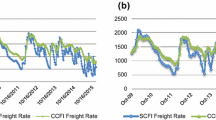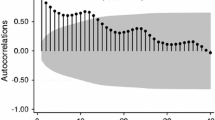Abstract
Major players in maritime business such as shipping lines, charterers, shippers, and others rely on container freight rate forecasts for operational decision-making. The absence of a formal forward market in container shipping necessitates reliance on forecasts, also for hedging purposes. To identify better performing forecasting approaches, we compare three models, namely autoregressive integrated moving average (ARIMA), vector autoregressive (VAR) or vector error correction (VEC), and artificial neural network (ANN) models. We examine the China Containerized Freight Index (CCFI) as a collection of weekly freight rates published by the Shanghai Shipping Exchange (SSE) for four major trade routes. We find that, overall, VAR/VEC models outperform ARIMA and ANN in training-sample forecasts, but ARIMA outperforms VAR and ANN taking test-samples. At route level, we observe two exceptions to this. ARIMA performs better for the Far East to Mediterranean route, in the training-sample, and the VEC model does the same in the Far East to US East Coast route in the test-sample. Hence, we advise industry players to use ARIMA for forecasting container freight rates for major trade routes ex-China, except for VEC in the case of the Far East to US East Coast route.


Similar content being viewed by others
Notes
TSA (March 5, 1989–February 8, 2018) was a freight rate discussion forum supported by the Federal Maritime Commission of the USA, comprising the 15 major container shipping lines operating on the transpacific trade lane. During its 29 years of operation, TSA had significant influence over transpacific freight rates, including GRIs, BAFs and seasonal surcharges.
Examined ANN models: (3,1,1), (3,2,1), (3,3,1), (3,4,1), (3,5,1), (3,1,1,1,), (3,2,1,1), (3,2,2,1), (3,3,1,1), (3,3,2,1), and (3,3,3,1)
References
Akaike, H. 1974. A new look at the statistical model identification. IEEE Transactions on Automatic Control 19 (6): 716–772.
Avdasheva, S., S. Golovanova, and G. Yusupova. 2018. Advance freight rate announcements (GRI) in liner shipping: European and Russian regulatory settlements compared. Maritime Economics & Logistics 21 (2): 192–206.
Batchelor, R., A. Alizadeh, and I. Visvikis. 2007. Forecasting spot and forward prices in the international freight market. International Journal of Forecasting 23 (1): 101–114.
Bollerslev, T. 1986. Generalized autoregressive conditional heteroscedasticity. Journal of Econometrics 31 (3): 307–327.
Box, G.E., and G.M. Jenkins. 1976. Time Series Analysis: Forecasting and Control, revised ed. San Francisco: Holden-Day.
Chen, G., N.G. Rytter, L. Jiang, P. Nielsen, and L. Jensen. 2017. Pre-announcements of price increase intentions in liner shipping spot markets. Transportation Research Part A: Policy and Practice 95: 109–125.
Chen, S., H. Meersman, and E. Van de Voorde. 2012. Forecasting spot rates at main routes in the dry bulk market. Maritime Economics & Logistics 14 (4): 498–537.
Clarksons. n.d. SIN - Shipping Intelligence Network, https://sin.clarksons.net/. Accessed 12 Jan 2018.
Clarksons. 2017. Container Intelligence Quarterly Q2/2017. London: Clarksons Research.
Clarksons. 2019. Container Intelligence Quarterly Q4/2019. London: Clarksons Research.
De Oliveira, G.F. 2014. Determinants of European freight rates: The role of market power and trade imbalance. Transportation Research Part E: Logistics and Transportation Review 62: 23–33.
Diebold, F.X., and R.S. Mariano. 1995. Comparing predictive accuracy. Journal of Business & Economic Statistics 13 (3): 134–144.
Drewry. 2012. Index-Linked Container Contracts. London: Drewry Shipping Consultants.
Duru, O. 2012. A multivariate model of fuzzy integrated logical forecasting method (M-FILF) and multiplicative time series clustering: A model of time-varying volatility for dry cargo freight market. Expert Systems with Applications 39 (4): 4135–4142.
Engle, R.F. 1982. Autoregressive conditional heteroskedasticity with estimates of the variance of UK inflation. Econometrica 50 (4): 987–1008.
Engle, R.F., and C.W. Granger. 1987. Co-integration and error correction: Representation, estimation, and testing. Econometrica 55 (2): 251–276.
Fan, L. 2011. Econometric analyses of container shipping market and capacity development. PhD thesis, The Hong Kong Polytechnic University, Hong Kong.
Gharehgozli, A., O. Duru, and E. Bulut. 2018. Input data range optimization for freight rate forecasting using the rolling window testing procedure. International Journal of Transport Economics 45 (3): 393–413.
Günther, F., and S. Fritsch. 2010. neuralnet: Training of neural networks. The R Journal 2 (1): 30–38.
Hair, J.F., et al. 2010. Multivariate Data Analysis. Pearson: Upper Saddle River NJ.
Haralambides, H.E., Fusillo, M., Hautau, U., Sjostrom, S., and Veenstra, A. 2003. The "Erasmus Report": Global Logistics and the Future of Liner Shipping Conferences. COMP/2002/16/SI2.346635. European Commission Competition Directorate General.
Haralambides, H.E. 2019. Gigantism in container shipping, ports and global logistics: A time-lapse into the future. Maritime Economics & Logistics 21 (1): 1–60.
Harper, Petersen. n.d. HARPEX, https://www.harperpetersen.com/harpex/harpexRH.csv. Accessed 12 Jan 2018.
Howe, Robinson. n.d. https://www.howerobinson.com. Accessed 12 Jan 2018.
Hyndman, R.J., and A.B. Koehler. 2006. Another look at measures of forecast accuracy. International Journal of Forecasting 22 (4): 679–688.
Hyndman, R.J., and Y. Khandakar. 2008. Automatic time series for forecasting: The forecast package for R (No 6/07). Journal of Statistical Software 27 (3): 1–22.
Jarque, C.M., and A.K. Bera. 1980. Efficient tests for normality, homoscedasticity and serial independence of regression residuals. Economics Letters 6 (3): 255–259.
Johansen, S. 1991. Estimation and hypothesis testing of cointegration vectors in Gaussian vector autoregressive models. Econometrica 59 (6): 1551–1580.
Karamperidis, S., E. Jackson, and J. Mangan. 2013. The use of indices in the maritime transport sector. Maritime Policy & Management 40 (4): 339–350.
Kavussanos, M.G., I.D. Visvikis, and R.A. Batchelor. 2004. Over-the-counter forward contracts and spot price volatility in shipping. Transportation Research Part E: Logistics and Transportation Review 40 (4): 273–296.
Kavussanos, M.G., I.D. Visvikis, and D.N. Dimitrakopoulos. 2015. Freight Markets and Products. In Handbook of Multi-Commodity Markets and Products: Structuring, Trading and Risk Management, ed. A. Roncoroni, G. Fusai, and M. Cumrins, 355–398. Hoboken: Wiley.
Li, K.X., G. Qi, W. Shi, Z. Yang, H.-S. Bang, S.-H. Woo, and T.L. Yip. 2014. Spillover effects and dynamic correlations between spot and forward tanker freight markets. Maritime Policy and Management 41 (7): 683–696.
Ljung, G.M., and G.E. Box. 1978. On a measure of lack of fit in time series models. Biometrika 65 (2): 297–303.
Lütkepohl, H. 1985. Comparison of criteria for estimating the order of a vector autoregressive process. Journal of Time Series Analysis 6 (1): 35–52.
Luo, M., L. Fan, and L. Liu. 2009. An econometric analysis for container shipping market. Maritime Policy and Management 36 (6): 507–523.
Miller, K., R. Ward, A.W. Craig, E.K. Lowe, C.A. Kroll, T. Hale, E. Miller, J. Cassels, S. Schöne, and A. Höth. 2015. Risk Management and Applications. In HSBA Handbook on Ship Finance, ed. O. Schinas, C. Grau, and M. Johns, 297–321. Berlin - Heidelberg: Springer.
Munim, Z.H., and H.J. Schramm. 2017. Forecasting container shipping freight rates for the Far East-Northern Europe trade lane. Maritime Economics & Logistics 19 (1): 106–125.
Narzo, Di A.F., Aznarte, J.L., and Stigler, M. (2018). Nonlinear Time Series Models with Regime Switching. https://cran.r-project.org/web/packages/tsDyn/tsDyn.pdf. Accessed 10 June 2018.
Nielsen, P., L. Jiang, N.G.M. Rytter, and G. Chen. 2014. An investigation of forecast horizon and observation fit’s influence on an econometric rate forecast model in the liner shipping industry. Maritime Policy & Management 41 (7): 667–682.
Notteboom, T., and P. Cariou. 2013. Slow steaming in container liner shipping: Is there any impact on fuel surcharge practices? The International Journal of Logistics Management 24 (1): 73–86.
PanCanal. 2017. Panama Canal Welcomes Largest Capacity Container Vessel To-Date Through Expanded Locks, Press Release, August 22, 2017, https://www.pancanal.com/eng/pr/press-releases/2017/08/22/pr632.html. Accessed 12 Jan 2018.
Phillips, P.C.B., and P. Perron. 1988. Testing for a unit root in time series regression. Biometrika 75 (2): 335–346.
Porter, J. 2016. Four weddings and a funeral, Containerisation International November Issue, 21–24.
Signals DPI. 2018. TSA Carrier Group Cancels FMC Agreement, Closes Office and Deletes Websites, Signals 22(3), March 2, 2018, https://www.dpiusa.com/archives/signals/180302.html#B.
Sims, C.A. 1980. Macroeconomics and reality. Econometrica 48 (1): 1–48.
Slack, B., and E. Gouvernal. 2011. Container freight rates and the role of surcharges. Journal of Transport Geography 19 (6): 1482–1489.
SSE. n.d. Shanghai Shipping Exchange. https://en.sse.net.cn/index.jsp. Accessed 12 Jan 2018.
SSE. 2019a. About SCFI. https://en.sse.net.cn/indices/introduction_scfi_new.jsp.
SSE. 2019b. About CCFI. https://en.sse.net.cn/indices/introduction_ccfi_new.jsp.
Stopford, M. 2009. Maritime Economics, 3rd ed. New York: Routledge.
Tsioumas, V., S. Papadimitriou, Y. Smirlis, and S.Z. Zahran. 2017. A novel approach to forecasting the bulk freight market. The Asian Journal of Shipping and Logistics 33 (1): 33–41.
UNCTAD. 2019. Review of Maritime Transport. Geneva: United Nations Conference on Trade and Development.
Veenstra, A.W., and P.H. Franses. 1997. A co-integration approach to forecasting freight rates in the dry bulk shipping sector. Transportation Research Part A: Policy and Practice 31 (6): 447–458.
VHBS. n.d. HAX - HAMBURG Index, https://www.vhbs.de/index.php?id=13&L=1. Accessed 12 Jan 2018.
Wackett, M. (2017). The ups and downs of container vessel scrapping as charter rates rise and fall. The Loadstar 14/06/2017, https://theloadstar.co.uk/ups-downs-container-vessel-scrapping-charter-rates-rise-fall/.
Wang, D.H., C.C. Chen, and C.S. Lai. 2011. The rationale behind and effects of Bunker Adjustment Factors. Journal of Transport Geography 19 (4): 467–474.
Yifei, Z., Z. Dali, and T. Yanagita. 2018. Container liner freight index based on data from e-booking platforms. Maritime Policy & Management 45 (6): 739–755. https://doi.org/10.1080/03088839.2018.1443224.
Yin, J., M. Luo, and L. Fan. 2017. Dynamics and interactions between spot and forward freights in the dry bulk shipping market. Maritime Policy & Management 44 (2): 271–288.
Yin, J., and J. Shi. 2018. Seasonality patterns in the container shipping freight rate market. Maritime Policy & Management 45 (2): 159–173.
Yun, H., S. Lim, and K. Lee. 2018. The value of options for time charterparty extension: An artificial neural networks (ANN) approach. Maritime Policy & Management 45 (2): 197–210.
Zamorano, J. and Martinez, K. 2016. Panama Canal opens $5B locks, bullish despite shipping woes. The Big Story. Associated Press June 26, 2016. Retrieved April 13, 2017.
Zhang, X., T. Xue, and H.E. Stanley. 2019. Comparison of econometric models and artificial neural networks algorithms for the prediction of Baltic Dry Index. IEEE Access 7: 1647–1657.
Zhang, H., and Q. Zeng. 2015. A study of the relationships between the time charter and spot freight rates. Applied Economics 47 (9): 955–965.
Acknowledgements
The authors thank the anonymous reviewers and Professor Haralambides for their useful suggestions. An earlier version of the manuscript was presented at the International Association of Maritime Economists 2018 conference in Mombasa, Kenya, where Ziaul Haque Munim received the Young Researcher Best Paper Award sponsored by the Kuehne Logistics University, Germany.
Author information
Authors and Affiliations
Corresponding author
Additional information
Publisher’s Note
Springer Nature remains neutral with regard to jurisdictional claims in published maps and institutional affiliations.
Rights and permissions
About this article
Cite this article
Munim, Z.H., Schramm, HJ. Forecasting container freight rates for major trade routes: a comparison of artificial neural networks and conventional models. Marit Econ Logist 23, 310–327 (2021). https://doi.org/10.1057/s41278-020-00156-5
Published:
Issue Date:
DOI: https://doi.org/10.1057/s41278-020-00156-5




